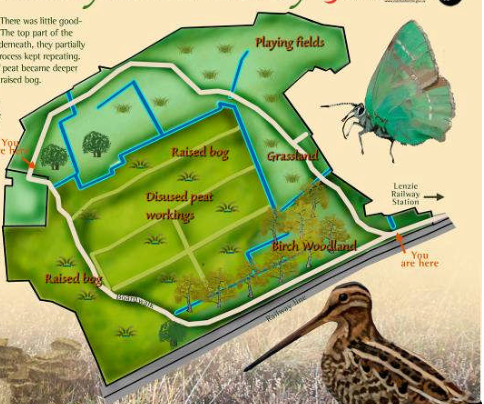In 1226, King Alexander II of Scotland gave permission for a monastery in Stirling to remove peat from wetlands to the northeast of the city of Glasgow. Having established a well-resourced and managed process to supply the estate of Stirling Castle from the more local peatlands, a lucrative income stream had been recognised, and a royal charter allowed the business to expand. No doubt avoiding any misgivings with a well-chosen Biblical justification, the monks leased the site to local merchants. Stirling was further away and not well connected by road, so it was gold and not decayed vegetation that travelled north. In this way, without having to do very much, the custodians of Cambuskenneth Abbey profited from the growing demand to fuel the rapid expansion of Glasgow and its surrounding townships.
In the centuries that followed, the monks transferred rights to the Kirkintilloch burgesses, who had tenanted the land for some time. These freemen of the borough became known as the Peat Lords. Under their supervision, peat was removed, dried and exported on an increasing scale, with local men employed to load up packhorses with sacks, which they transported to the neighbouring towns and villages and sold on to an expanding population. The product was burned in cottages, manors and kirks. Unbeknowingly, carbon coursed into the atmosphere. From time to time, fires took hold on the land itself. Sometimes, these were started deliberately.
While each of the preceding decades had brought with them only another centimetre of peat, the extraction process was far quicker. Bogs were drained, canals formed, and the exposed peat was cut into sections, which were lifted, shifted and dried in stacks. Sheep and cattle grazed the edges, homes were built on the steadier land, rubbish was dumped among the heather and the grasses. Once, a well-preserved body was discovered but never identified. Mostly, this land of moss and fungi held its secrets.
In the early twentieth century, the industry was gathering pace, and a new company served a growing demand from farms and gardens. Wooden carts travelled back and forth along a railway siding near the main train station. A processing plant was built to house new machines for cutting, shredding, baling and stacking. The Moss became a busy industrial site, and the demands of the modern world transformed the landscape. The raised bog was levelled and covered in baulks and ditches. As the ground became scarred and broken, centuries of extractive industry began to falter. There was plenty more decomposing organic matter in there, but it was harder to get to and there was less demand as coal and gas moved into some of the places where peat had previously been required.
In the second part of the century, the company ceased operations and the platforms, rail line and buildings were sold off or slowly fell into ruin. A thirsty birchwood grew around the edges of the site. The Moss became bordered and hemmed in by residential areas and asphalt roads. Its boundaries became harder. The land was surveyed, plans were drawn up, proposals lodged. As the extraction of peat became less viable as a way to squeeze a profit from the land, the possibility of building onto it was explored. But as the town grew, more people cared about what happened to the site. A voluntary association was formed, which campaigned to protect the peatlands and fought the housing plans.
The Moss was designated as a Local Nature Reserve and as heather crept over the remaining raised areas, a complex ecosystem began to flourish with mosses, butterflies, frogs, kestrels and voles. Scientific and public understanding of carbon storage and climate change grew. Conservation was taken up in political debates and everyday conversations. Laws banned extraction. Families, dog walkers and joggers moved into the space vacated by the peatworks. Maps were redrawn.
